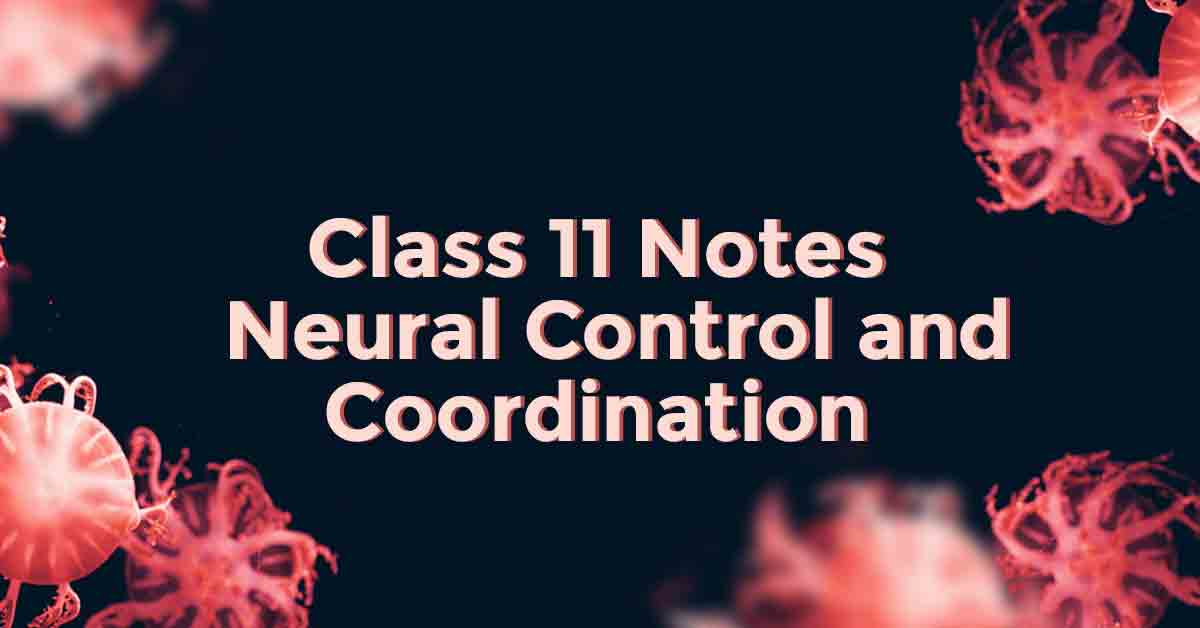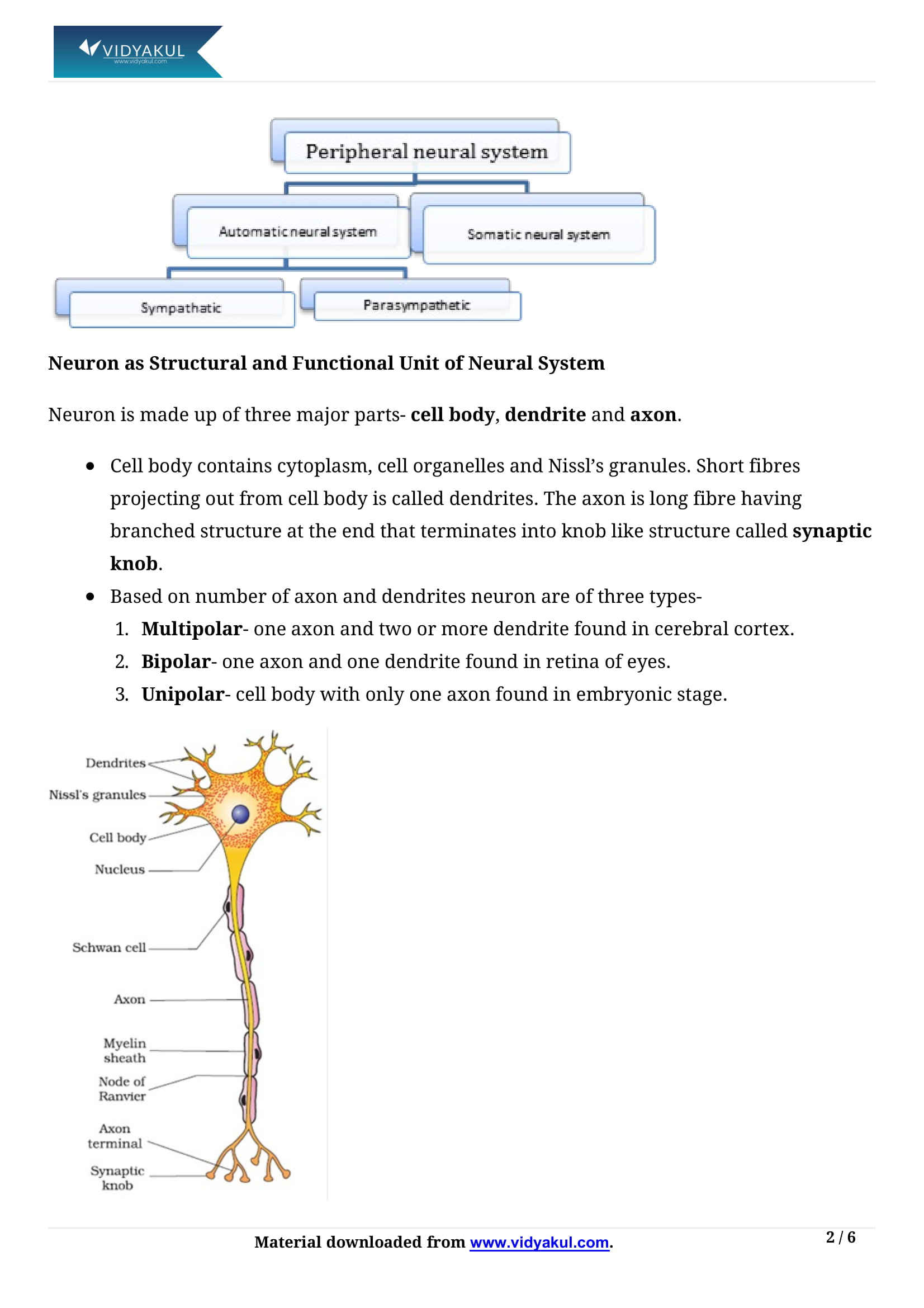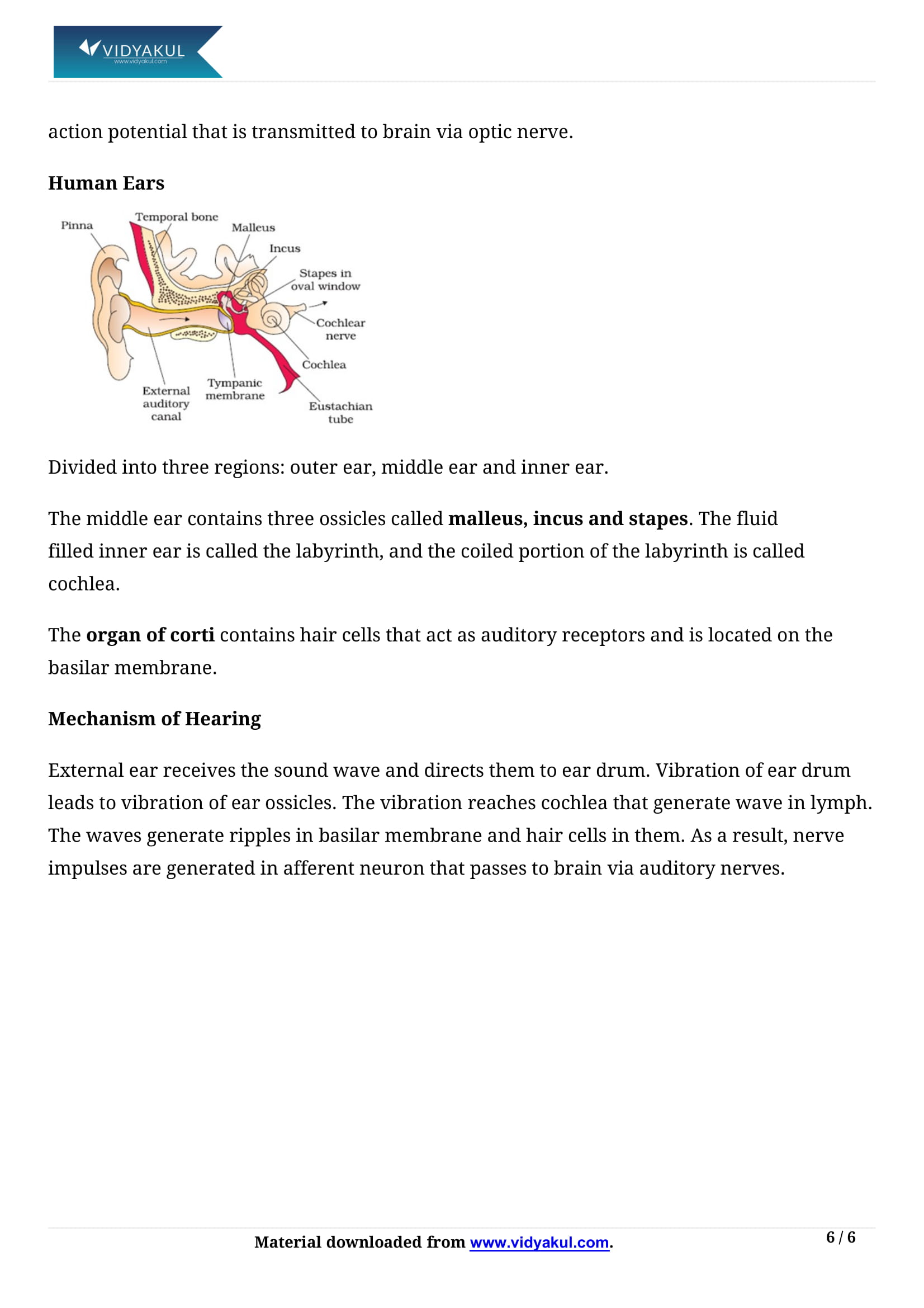Neural Control and Coordination Class 11 Notes

Chapter 21 Neural Control and Coordination
NCERT notes play an important role during testing. NCERT notes help students understand control and coordination between different parts of the body. The nervous system provides a point-to-point network of connections for coordination. Vidyakul's NCERT notes is based on this concept.
Vidyakul offers students a free detailed notes to Chapter 21 of Year 11 Biology. Vidyakul's NCERT Class 11 biological notes is based on the latest CBSE program. Also, these notes clarify the basics of the chapters and expand your knowledge. Students must solve problems to stay ahead of the competition.
CBSE CLASS 11 BIOLOGY CH-21
Points to Remember
Some of the important points to remember from Class 11 Biology Chapter 21 are as follows:
The neuroendocrine system controls, integrates, and coordinates all bodily functions.
Animals have a nervous system, while plants do not.
The nervous system is comprised of two types of cells: neurons and glial cells.
Neurons are the nerve system’s functional units.
Supporting cells are glial cells.
The brain is divided into three sections: forebrain, midbrain, and hindbrain.
The cerebrum, thalamus, and hypothalamus make up the forebrain.
The cerebrum is the brain’s largest structure.
Topics and Sub-topics
The topics covered in both 11th and 12th are related; hence, it is important to understand the common concepts. Therefore, students need to understand the importance of the topics covered in Biology Chapter 21. The topics in this chapter explain that coordination is the process through which two or more organs interact. Such control and coordination is happening all the time in our body. The neural system in our body controls this complete process.
In this chapter, students will learn about the neural system of humans and the mechanisms of neural coordination. The NCERT Class 11 notes will help students understand the concepts easily. Students can practice these concepts available at Vidyakul for free. It makes learning fun for students in this way. Now, let us look at the important topics covered in this chapter:
Frequently Asked Questions
Describe the phenomena of release and transport of a neurotransmitter.
Synapses are junctions that transmit nerve impulses from one to another neuron. It is produced through the membranes of the postsynaptic and presynaptic neuron that may be or may not be parted by a synaptic cleft which is a gap. The membranes of the presynaptic and postsynaptic neurons at a chemical synapse are divided by a space filled with fluid known as the synaptic cleft. The neurotransmitters transmit impulses at such synapses. The axon terminals possess vesicles that have the neurotransmitters. When an impulse arrives, it reaches the axon terminal and triggers the action of the synaptic vesicles supporting the membrane wherein they join with the plasma membrane to produce their neurotransmitters, all in the synaptic cleft, which in turn attach to their particular receptors situated on the postsynaptic membrane. This union unfolds ion channels permitting the entrance of ions which can produce a new potential in the postsynaptic neuron which can either be inhibitory or excitatory.
List the human forebrain parts representing their respective functions.
The human forebrain comprises of the cerebrum, hypothalamus, and the thalamus. The main component of the human brain is formed by the cerebrum which is separated longitudinally by a cleft into 2 halves, named as the left and the right cerebral hemisphere which are linked by a tract of nerve fibres known as the corpus callosum. Cerebral hemisphere is covered by a cell layer known as the cerebral cortex having evident folds. Its greyish appearance attributed by the cell bodies of the neuron is the reason the cerebral cortex is termed as the grey matter. It contains sensory areas, motor areas, and large regions which are neither motor nor sensory in function, and are referred to as association areas responsible for functionalities such as intersensory associations, communication, and memory. The inner part of the cerebral hemisphere is constituted by the fibres of the tracts comprised of the myelin sheath. It is called as the white matter as they impart an opaque white appearance to the layer. The thalamus is contained in the cerebrum which coordinates the motor and sensory signalling. At the base of the thalamus is the hypothalamus, containing several centres regulating the impulse for eating, drinking and body temperature. It also has a number of neurosecretory cells that produce hormones known as hypothalamic hormones. The limbic system is formed by the internal parts of the cerebral hemispheres and a combination of related deep structures such as the hippocampus, amygdala, etc. This system accompanying the hypothalamus is concerned with controlling sexual behaviour, expressing emotional reactions, motivation, etc.
Describe the structure of the internal and middle ear.
Ears are a pair of a statoacoustic organ that helps in balancing and hearing. The human ear includes – the middle ear, the inner ear, and the internal ear. The pinna is a part of the auditory system and forms the external ear. The middle ear has 3 bones – the malleus(hammer), the stapes(stirrup) and incus(anvil) which are attached in a chain-like pattern. The stapes is connected to the oval window of cochlea and the malleus is connected to the tympanic membrane. These three bones or ossicles raises the productivity of communication of sound waves to the inner ear. The middle ear leads to the Eustachian tube that bridges along with the pharynx and controls the force between the outside and the middle ear. The inner ear comprises a labyrinth of chambers filled with fluids inside the temporal bone of the skull. The labyrinth has 2 parts – the membranous and the bony labyrinth(series of channels). Inside the channels lies the membranous labyrinth which is girdled by a fluid known as perilymph and filled with a fluid called endolymph. The labyrinth has a coiled structure called the cochlea. Which has 2 large canals – upper vestibular canal and a lower tympanic canal that is divided by a small cochlear duct. Both canals contain the perilymph with endolymph in the cochlear duct. Towards the base of the scala vestibuli, the membranous labyrinth walls are in sync with the fenestra ovalis and at the lower end of the scala tympani is the fenestra rotunda.
Write the similarities between computers and neural system. ( Hint: CPU, input-output devices)
Various organs possess sensory neurons which sense the surroundings and send across the communication to the brain which is similar to the input device in computers. The human brain can be compared to the Central Processing Unit (CPU). The data that is gathered by the sensory neurons is processed by the brain which further commands the specific organ to work in accordance. Finally, the message is picked by the motor neurons that are similar to output devices.
How could it affect a person’s CNS if he is attacked by a blow on the back of the neck?
It would lead to an impairment of cognitive abilities or dysfunctionalities physically. Furthermore, it can also cause disturbance of emotional or behavioural functioning. Cervical damages can lead to tetraplegia.
What is the role attributed to the Eustachian tube?
It connects the pharynx with the middle ear cavity and aids in equalizing pressures on both the parts of the eardrum. There is a valve present towards the pharyngeal opening of the tube that remains closed usually. It opens during swallowing, yawning, an unexpected change in altitude when the air leaves or enters the tympanic cavity so as to stabilize the air pressure on both parts of the tympanic membrane.
What are the functions of the Eustachian tube?
The eustachian tube is also called a pharyngotympanic tube. The Eustachian tube has many functions, the most notable are:
Facilitates the secretion drainage from the middle ear.
It connects the middle ear cavity with the nasopharynx.
Equalize the pressure between the middle ear and atmosphere.
Practice Questions
List the structures that protect the brain.
What do the white and grey matter in the human brain indicate?
State the difference between chemical and electrical transmission.
Write the similarities between computers and neural system
Rearrange the following in the sequential order of reception and transmission of sound waves from the eardrum –
External auditory nerve, eardrum, cochlear nerve, malleus, stapes, incus, cochlea
The neuroendocrine system controls, integrates, and coordinates all bodily functions.
Animals have a nervous system, while plants do not.
The nervous system is comprised of two types of cells: neurons and glial cells.
Neurons are the nerve system’s functional units.
Supporting cells are glial cells.
The brain is divided into three sections: forebrain, midbrain, and hindbrain.
The cerebrum, thalamus, and hypothalamus make up the forebrain.
The cerebrum is the brain’s largest structure.
Describe the phenomena of release and transport of a neurotransmitter.
List the human forebrain parts representing their respective functions.
Describe the structure of the internal and middle ear.
Write the similarities between computers and neural system. ( Hint: CPU, input-output devices)
How could it affect a person’s CNS if he is attacked by a blow on the back of the neck?
What is the role attributed to the Eustachian tube?
What are the functions of the Eustachian tube?
Facilitates the secretion drainage from the middle ear.
It connects the middle ear cavity with the nasopharynx.
Equalize the pressure between the middle ear and atmosphere.
List the structures that protect the brain.
What do the white and grey matter in the human brain indicate?
State the difference between chemical and electrical transmission.
Write the similarities between computers and neural system
Rearrange the following in the sequential order of reception and transmission of sound waves from the eardrum –
Learn more about it in Neural Control and Coordination Class 11 Notes pdf.
Download this solution for FREE Download this PDF
Download Vidyakul App for more Important videos, PDF's and Free video lectures.









